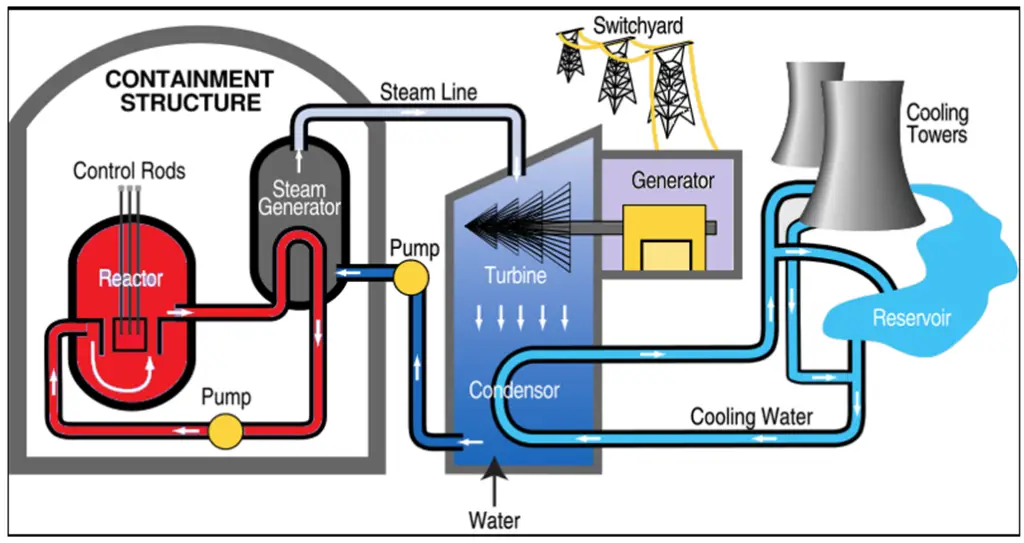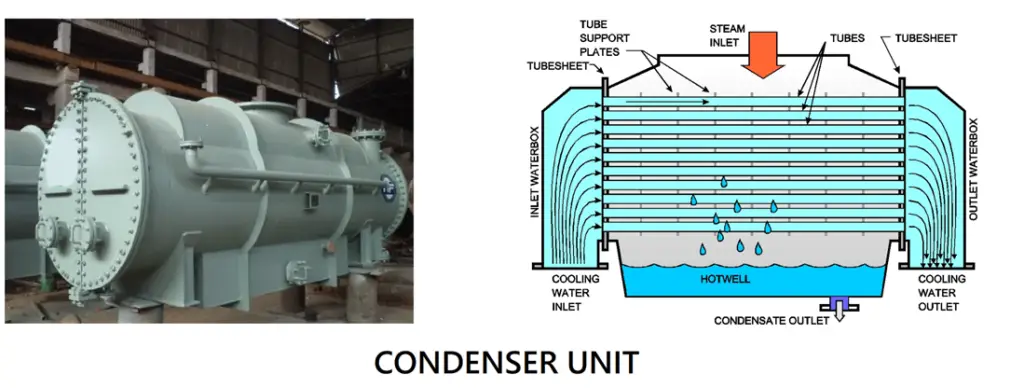This article describes a comprehensive nuclear power plant diagram to gain insights into the intricate components and processes involved in harnessing nuclear energy. The detailed illustration in this article provides functions of reactor cores, cooling systems, turbines, and more, offering a clear understanding of how power is generated in nuclear power plants.
Thermal power plants around the world work on the same principle – heating water and generating steam that can be used to rotate a turbine. This turbine is coupled to a generator which therefore rotates and generates electricity. Thus, any power plant converts the heat energy into electrical energy. However, the fuel used to generate the required amount of heat energy changes. It can be coal-based, fossil fuel-based, or it can be based on nuclear power. Here, we are going to discuss the working of a nuclear power plant and its different components in detail.
Table of contents
Importance and contribution of Nuclear power
Before we go any further, it is important to look at the contribution of nuclear power stations to the overall energy mix around the world so that we can understand its importance and be informed about its prospects.
According to the International Energy Agency (IEA), Nuclear power contributes about 10% of global electricity generation, whereas its contribution to India’s energy mix is about 1.76% as per the NITI Aayog Energy Dashboard, Govt. of India.
Nuclear power is considered one of the cleaner sources of energy with very low carbon emissions. With more focus on clean and green energy, the share of nuclear power in the total energy mix is going up steadily. Also, the rising cost of rapidly depleting fossil fuels around the world and the need for a dispatchable power source that can complement renewable sources to maintain electricity security has renewed the focus on nuclear power plants.
Working Principle of a Nuclear Power Plant
As we discussed above, the most important part of any thermal power plant is the generation of heat energy and the fuel used for the same. In the case of a nuclear power plant, the required amount of heat energy is generated by a nuclear fission reaction. A nuclear fission reaction is one in which the nucleus of the atom of a heavy element like Uranium or Thorium is split into smaller nuclei, followed by the generation of heat energy. This energy is utilized in the case of nuclear power plants.
For the nuclear fission reaction to take place, radioactive elements like Thorium or Uranium are taken to a nuclear reactor. The atom of the radioactive element is bombarded with neutrons. As neutrons have no charge, they aren’t repelled by the nucleus of the atom. This bombardment initiates the fission reaction, where the nucleus of the radioactive element splits into smaller nuclei, along with the generation of heat energy and more neutrons. The generated neutrons again initiate the fission reaction, causing the generation of more energy and more neutrons. Thus, this keeps going in a cycle and generates a huge amount of heat energy as required.
Here’s the nuclear fission reaction of a Uranium atom (U-235).

How Does A Nuclear Power Plant Work?
As discussed above, the nuclear fission reaction occurs in a nuclear reactor. The central part of the nuclear reactor is known as the core, which has the uranium or thorium fuel present in ceramic pellets. Each pellet generates energy equivalent to that of 150 gallons of oil energy. The total energy from the pellets is stacked in metal fuel rods.
The nucleus of the radioactive material present within the nuclear reactor as the fuel is bombarded by neutrons, thus causing the generation of daughter nuclei along with heat energy and more neutrons. These generated neutrons maintain the chain reaction of nuclear fission, thus causing the generation of an enormous amount of heat energy, which is used to generate steam from the water. This high-pressure steam hits the turbine blades, which in turn rotates a generator and causes the generation of electricity.
To keep the chain reaction in control and to prevent the nuclear reactor from turning into a nuclear detonator, a couple of neutrons are taken away after each chain reaction to keep the system in balance.
Let’s look at each component of a nuclear power plant.
Layout and Diagram of a Nuclear Power Plant
The picture below shows a nuclear power plant’s overall layout and diagram with all its components.

Components of a Nuclear Power Plant
Nuclear Reactor:
A nuclear reactor is one of the most important components of a nuclear power plant. The central core of the nuclear reactor consists of radioactive fuel like Uranium or Thorium, which undergoes a fission reaction and generates heat. This heat is generated within the walls of the nuclear reactor, which is utilized for generating steam from water.
As a chain of nuclear fission reactions goes on within the nuclear reactor, the amount of energy released is enormous. The nuclear reactor is strong enough to withstand the internal pressure and the heat generated. Water is sprayed from a dousing tank to lower the internal pressure within the reactor.
Nuclear fission reaction within the nuclear reactor causes the generation of nuclear waste as well, which needs to be treated and neutralized before being disposed of to avoid any negative impact on the nearby environment.

Two types of nuclear reactors that are widely used –
- Pressurised Water Reactor (PWR):
This type of reactor uses regular water as a coolant. The water is kept at a high pressure to prevent it from boiling. The heated water is then transferred through a heat exchanger, where it converts water from the secondary coolant loop into steam, leaving the secondary loop free from any radioactive substances. In a PWR, the coolant water itself acts as a moderator, making pressurized water reactors the most commonly used type of reactor due to their numerous advantages. - Boiling Water Reactor (BWR) –
A boiling water reactor (BWR) has only one coolant loop. The water is allowed to boil within the reactor, and the steam generated flows through a steam turbine. However, a significant drawback of the BWR is that the coolant water comes into direct contact with fuel rods and the turbine, which could result in radioactive material being deposited on the turbine.
Steam Generator:
A steam generator is a heat exchanger component that transfers the heat generated within the nuclear reactor’s core to the steam supply system’s secondary side. The transferred heat is used to convert water into high-pressure steam.
Steam Generators are used in pressurized water reactors between the primary and secondary coolant loops. The primary loop carries extremely hot water for heating and exchange. Once water at a low pressure is circulated, it warms the water to generate the steam to transmit to the turbine section.

Steam generators have to fulfill special nuclear regulatory requirements regarding their size, selection of materials, pressure loads, impact on the overall plant safety, etc.
Steam Turbine:
The high-pressure steam generated from the steam generator by heating water is utilized to make a turbine rotate. This turbine acts as a prime mover for an electrical generator that generates the electricity.

Alternator
The steam turbine rotates the shaft of an alternator, generating electrical energy. The electrical output is then transferred over distances using a step-up transformer.
Control Rods:
Within the nuclear reactor, a nuclear fission reaction starts by bombarding the Uranium atom by neutrons. The reaction produces more neutrons, which initiates a chain of nuclear fission reactions, thus causing the generation of the enormous amount of heat energy required for the plant to operate. But the number of neutrons generated after each fission reaction keeps on multiplying and rising exponentially. If these generated neutrons are not controlled, the fission reaction can go out of control, thus causing the nuclear reactor to turn into a nuclear bomb. Hence, control rods, which absorb a certain number of neutrons after each fission reaction, are used so that the chain reaction remains in control and generates the required adequate thermal energy.
Uranium-235 fission releases 2.5 neutrons on average, but only one neutron is needed to sustain the nuclear chain reaction at a steady rate. The control rods absorb these extra neutrons and can be used to adjust the reactor’s power output.
Control rods provide real-time control of the fission process, ensuring it remains active while preventing it from accelerating out of control. Generally, control rods are made using cadmium, hafnium, or enriched boron, which are known for their neutron-absorbing ability.

Condenser and Cooling Tower:
The high-pressure steam that is used to rotate the turbine can be reused to increase the overall plant efficiency. Otherwise, this high-temperature steam will escape the plant after being utilized in the turbine. Thus, the steam is passed through a condenser unit after its work is done. The condenser acts as a heat exchanger where the high-temperature steam exchanges heat with the cold water supplied by the cooling tower. As a result, the steam cools down to water, which is again pumped back to the steam generator unit.

On the other hand, the cold water from the cooling tower absorbs the heat from the steam and goes back to the cooling tower. In the cooling tower, this hot water releases its heat into the atmosphere and cools down. This water is again used for heat exchange within the condensing unit.

This is all about the overall working of a Nuclear power plant.
Conclusion
In conclusion, the simplified nuclear power plant diagram makes it easy to understand the fundamental aspects of harnessing nuclear energy. One can understand the intricate workings of a nuclear power plant by understanding the key components and processes visually depicted in the diagram and layout.